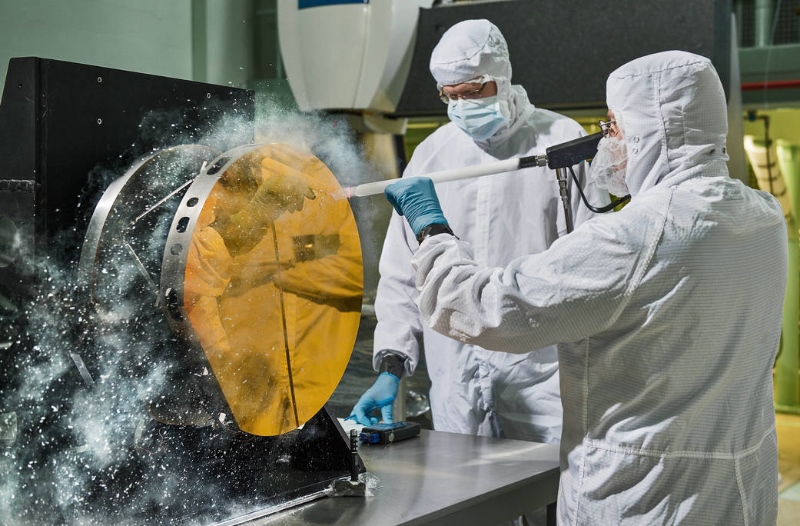
This is a new technique for spacecraft sterilization explored by ESA. See Deep cleaning with carbon dioxide. and Science Daily article about it. JPL are also exploring it. The great advantage of this is that it sterilizes at low temperatures, has no effect on electronics, and also removes the organics completely if the robot starts off reasonably clean. It can also penetrate into tiny cracks and holes. If it can be made 100% effective, you not only get no life on the spacecraft, but no DNA fragments or GTAs or anything organic at all.
There are two ways to do it. One is to use supercritical liquid carbon dioxide, and enclose the instrument in a pressure vessel. This is great for small and delicate parts. The other way is to generate tiny particles of carbon dioxide snow which impacts on the surfaces. See also wikipedia article on carbon dioxide cleaning.
Another advantage is that the supercritical carbon dioxide penetrates into tiny holes, dissolves the organics, and then a the snow escapes taking the organics with it, it changes back from solid to gas, so leaving the spacecraft completely dry with no residue.
The pressurized supercritical method is:
We could use this, first on Earth before the final heat sterilization stage, and afterwards as well if we can figure out a way to do it without recontamination. But we could also take a container of CO2 and use it for a final CO2 snow sterilization stage for the lander during the mission to Europa. This is rather like the idea of using the carbon dioxide in the Mars atmosphere for an extra CO2 snow sterilization stage after landing there.
The impacting snow method is what ESA are using already in an operating spacecraft clean room. It has additional advantages that it removes impurities that could interfere with electronics.
They mix the liquid CO2 in advance with clean dry air, where it forms tiny snowflakes. So they then hit the spacecraft with minute snowflakes which penetrate into every nook and cranny. The spacecraft surfaces, which are relatively hot for the snowflakes, so they expand 800 fold, in mini explosions, taking the organics and other matter away with them. So instead of injecting with supercritical liquid which forms snowflakes later, they hit the surface with minute CO2 snowflakes. They plan to use this method to help with sterilizing ExoMars due for launch in 2018. See this press release from August 2015.
"The method originates from the USA, and is used to remove paint from aircraft fuselage. A powerful jet of frozen carbon dioxide (CO2) crystals, about the size of a rice kernel, blasts the paint right off the metal. The researchers made this crude instrument substantially more refined. Instead of CO2 pellets, they use carbon dioxide snow to work on each individual component – from the highly sophisticated aluminum workbench to the ring washers. Here’s the rub: the beam that the jet emits is additionally accelerated with a blast of CDA (clean dry air) that encases it. This is how it penetrates into every nook and cranny, removing even the minuscule pollutant. As soon as the tiny snowflakes hit the relatively hot surface, they become gaseous, causing their volume to explosively expand 800-fold. The detonation pressure completely sweeps away every single bit of dust, even fingerprints which the cold gas had just turned brittle. “This approach involves a dry process that does not warp surfaces. When cleaning, these can be gently treated with CO2. That makes it unnecessary to apply heat or chemicals,” Gommel says when explaining the advantages of this method. "
More about planetary protection for ExoMars here.
This shows scientists using a similar technique to clean all the organics from the surface of a test mirror:

Scientists using CO2 snow cleaning to clean a test mirror - if the James Webb mirror gets contaminated by organics they can clean it in this way before the launch. The advantage of this approach is that it doesn't just sterilize the equipment. It also removes all trace of organics.
A similar method can be used to clean electronics and spacecraft and remove all organics from them.
Of course this adds somewhat to the complexity of the mission. But if you value the Europa ocean highly, then it's worth it, to make sure we have no practical chance of making life there extinct.
For more ideas see the sections below: Can we achieve 100% sterile electronics for an Europa, Enceladus, Ceres, or Mars lander?
However, whether we can make the lander 100% sterile and free of GTAs and other possibly problematical organics at this stage or not, another question is - is this the best thing to do at this stage anyway? And what are the best instruments to send to Europa to search for life?